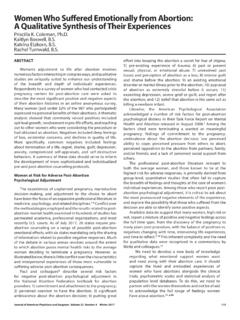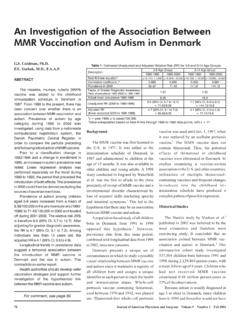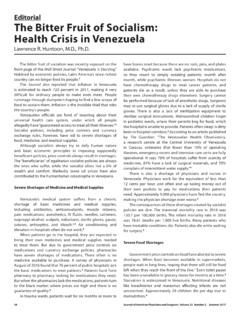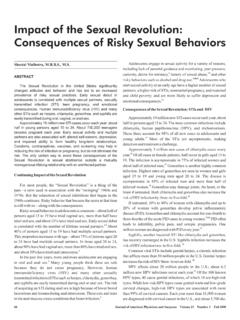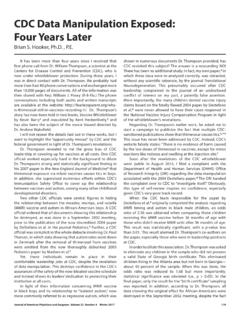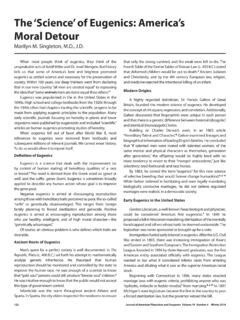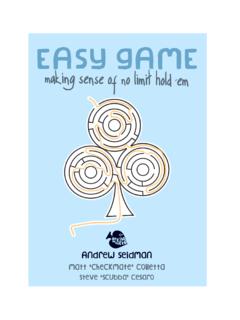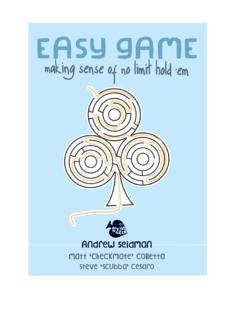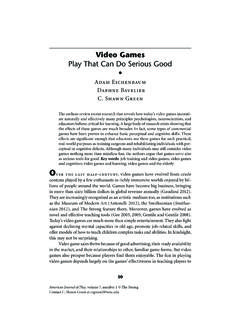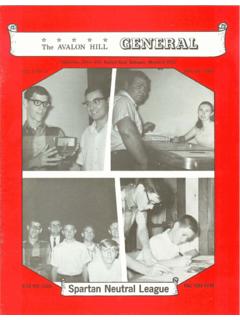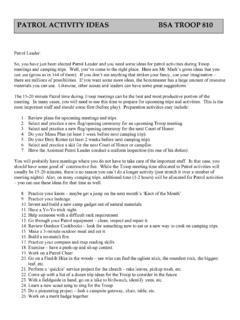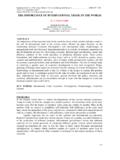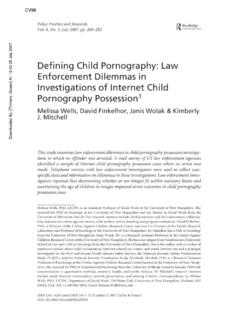Transcription of DDT: A Case Study in Scientific Fraud - jpands.org
1 J. Gordon Edwards, of Pesticides to HumanityABSTRACTThe chemical compound that has saved more human lives thanany other in history, DDT, was banned by order of one man, thehead of the Environmental Protection Agency (EPA). Publicpressure was generated by one popular book and sustained byfaulty or fraudulent research. Widely believed claims ofcarcinogenicity, toxicity to birds, anti-androgenic properties, andprolonged environmental persistence are false or grosslyexaggerated. The worldwide effect of the ban has beenmillions of preventable in science is a major problem. A 2002 report published bythe American Association for the Advancement of Science (AAAS)on Fraud in science in Germany stated that InternationalScientific Misconduct Rules should punish deliberate or grosslynegligent falsification or fabrication of data, and that failure tocooperate with investigations will be considered an admission ofguilt.
2 Ombudsmen will be appointed to probe for examples ofmisconduct, including falsification, fabrications, selective use ofdata, and manipulation of graphs and figures. Upon reading thisarticle, I prepared a 34-page list of frauds published in journals and sent it to the editor of. Although heresponded courteously, he evidently did not wish to publicize most common examples of Fraud in the United Statesappear to be environmental, including acid rain, ozone holes,carbon dioxide, ultraviolet radiation, global cooling, globalwarming, endangered species, and pesticides. This article willprimarily concern the last, especially (dichlorodiphenyltrichloroethane) was first produced in1874 by German chemist Othmar Zeidler, but he did not suggestany actual use for it.
3 Sixty years later, Paul M ller duplicated theprocedure and discovered the chemical s insecticidal potential. Forthis, he received the Nobel Prize in has been effective in controlling mankind s worst insectpests, including lice, fleas, and mosquitoes. This was of enormousimportance for human health because at least 80 percent of humaninfectious disease worldwide is arthropod borne. Hundreds ofmillions have died from malaria, yellow fever, typhus, dengue,plague, encephalitis, leishmaniasis, filariasis, and many otherdiseases. In the 14th century bubonic plague (transmitted by fleas)12 Sciencekilled a fourth of the people in Europe and two-thirds of those in theBritish Isles. Yellow fever killed millions before it was found to betransmitted bymosquitoes.
4 It infected British troops in theLouisiana Territory in 1741, killing 20,000 of the 27,000 1802, French troops arrived there but departed after 29,000 of the33,000 soldiers died of yellow fever. More than 100 epidemics oftyphus ravaged civilizations in Europe and Asia, with mortalityrates as high as 70 percent. But by far the greatest killer has beenmalaria, transmitted 1945 the goal of eradicating this scourge appeared to beachievable, thanks to DDT. By 1959, the , Europe, portions ofthe Soviet Union, Chile, and several Caribbean islands were nearlymalaria free. In 1970 the National Academy of Sciences stated: To only a few chemicals does man owe as great a debt as to little more than two decades DDT has prevented 500 millionhuman deaths due to malaria that would have otherwise have beeninevitable.
5 Today, however, after the ban on DDT, there is a globalmalaria burden of 300 to 500 million cases and 1 to milliondeaths annually,mostly among young children. Malaria kills anAfrican child every 30 South American countries suffered more than 90 percentincreases in malaria rates after halting DDT use, but Ecuador usedDDT again and enjoyed a 61 percentin the first page of the book widely credited with launching theenvironmental movement as well as bringing about the ban onDDT, Rachel Carson wrote: Dedicated to Dr. Albert Schweitzer,who said Man has lost the capacity to foresee and forestall. He willend by destroying the earth . She surely knew that he wasreferring to atomic warfare, but she implied that he meant therewere deadly hazards from chemicals such as DDT.
6 Because I hadalready found a great many untruths in her book, I obtained a copyof Dr. Schweitzer s autobiography, to see whether he evenmentioned DDT. He wrote: How much labor and waste of timethese wicked insects do cause, but a ray of hope, in the use of DDT,is now held out to us. Many allegations have been made about the harmful effects ofpesticides in general, and DDT in particular, on human health. Evenstatements about the amount actually ingested by human beingshave been dramatically ,678910 Rachel Carson sEffects of Pesticides on Human BeingsSilent SpringDDT: A Case Study in Scientific Fraud83 Journal of American Physicians and Surgeons Volume 9 Number 3 Fall 2004On May 15, 1975, the Environmental Protection Agency(EPA) released a report claiming that people in the United Stateswere ingesting 15 milligrams of DDT every day.
7 In response to aletter stating that this was obviously untrue, an EPA officialresponded: You are correct in stating that EPA s DDT reporterred on human dietary uptake. The correct figure should havebeen 15per day, instead of 15per day (Laurence O Neall, personal communication, Sept. 11, 1975). Hestated that We will make every effort to rectify the erroneousfigures with the news media. Indeed, the EPA did issue acorrection stating that the actual number was a thousand times lessthan that given in their volunteers in Georgia ingested up to 35 milligramsdaily, for nearly two years, and did not experience any difficultiesthen or later. Workers in the Montrose Chemical Company had1,300 man-years of exposure, and there was never any case ofcancer during 19 years of continuous exposure to about 17mg/ were sometimes raised about possiblecarcinogenic effects of DDT, but instead its metabolites were oftenfound to be-carcinogenic, significantly reducing tumors in ingestion induces hepatic microsomal enzymes, whichdestroy carcinogenic aflatoxins and thereby inhibit an 80-day hearing in 1972 on the potential forcarcinogenicity, the EPA concluded that DDT is not a carcinogenichazard for man.
8 Nevertheless, EPA Administrator WilliamRuckelshaus banned DDT two months later, stating that DDTposes a carcinogenic risk to humans. The primary evidence usedto support his assertion was two animal studies. The first waschallenged because it was not replicated by other workers usingsimilar dosages and because the findings might have resulted fromfood contaminated with aflatoxin. The second Study , which used anearly lethal dose, reported hepatomas in 32 percent of theexperimental group compared to 4 percent of the control , the tumors were not shown to be malignant, and the litterswere not distributed anti-DDT activists alleged that DDT was killing birds orcausing them to produce thin-shelled eggs.
9 Some extremists evenwrote that because of DDT birds dropped from the sky, dead. Others said that birds were falling out of trees by the thousands. No such tragedies actually occurred, not even to a few birds. It waseasy to test such claims of toxicity by simply feeding knownquantities of DDT to caged birds. Even extreme amounts of DDT inthe food did not seriously poison Carson declared that like the robin, another Americanbird, [the Bald Eagle] seems to be on the verge of extinction. Thatsame year Roger Tory Peterson, America s greatest ornithologist,wrote that the robin was the most abundant bird in NorthAmerica. There is no doubt as to which writer was correct!During the DDT Years, the Audubon Christmas Bird Countspublished the numbers seen per observer in 1941 (pre-DDT) and1960 (after peak use of DDT).
10 The actual numbers seen increasedmicrogramsmilligramsanti111213, 1415,16173318199202122 The Effect of DDT on Birdsfrom 90 birds seen per observer in 1941 to 971 birds seen perobserver in , the counts of raptorial birds migrating over HawkMountain, Pennsylvania, indicated that there were many morehawks there during the DDT years than previously. The numberscounted there increased from 9,291 in 1946 (before much DDT wasused) to 13,616 in 1963 and 29,765 in 1968, after 15 years of heavyDDT Massachusetts, herring gulls on Tern Island increased from2,000 pairs in 1940 (before DDT) to 35,000 pairs by 1970, beforeDDT was banned. Gulls were on the state s list of protected seabirds, but the Audubon Society was permitted to poison 30,000 ofthem there.
